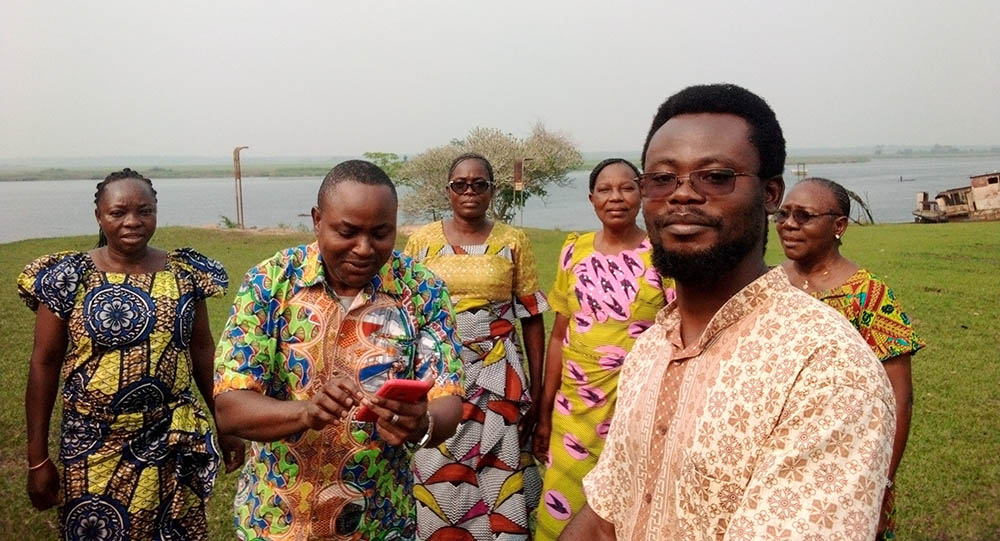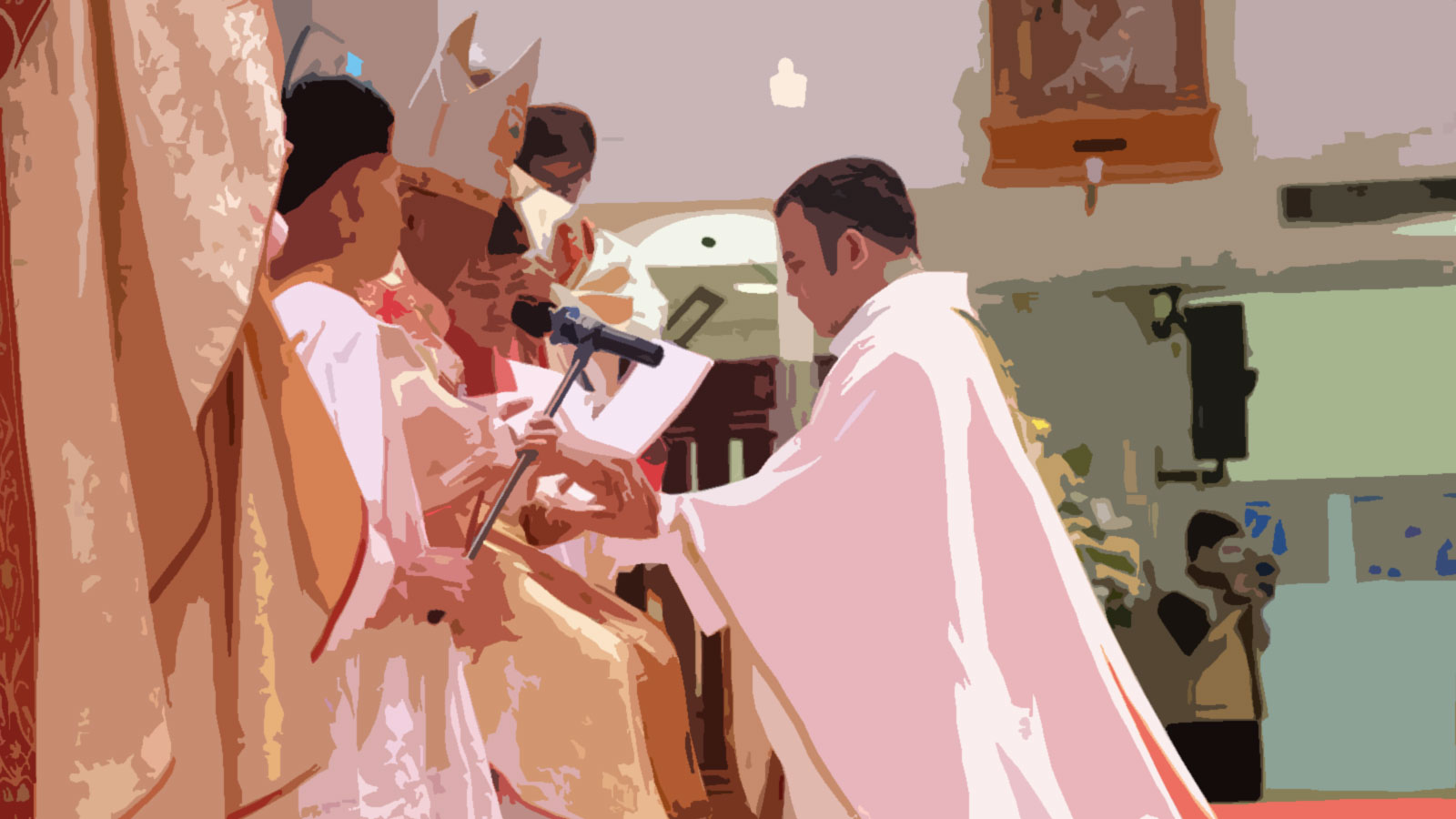
Fr. Germain Nsasi Yengo, cicm
Missionary in Belgium
I was asked to write about the Lonkesa mission and its refounding context. This article shares my missionary experience and the results of an in-depth observation process.
The detailed analysis of the Lonkesa mission can be seen as a critique of the missionary objective. Some confreres express concern about our presence. What's happening in Lonkesa? What are you doing there? Is the new parish under construction? The explanation of the mission that follows will answer these questions, starting with our arrival in Lonkesa.
We left Kinshasa on Friday, March 26, 2021. Fr. Constantin Sakamba, Deacon Boniface Mwawatadi, Fr. Bernard Kambala, I, Germain Nsasi Yengo, and the driver, Mr. Servais Phuati (Papa Mapéché), were on board the vehicle. On Saturday evening, we finally reached Isaka Beach. A motorized pirogue took us first to Nioki with our missionary baggages.
After a good night's sleep at the house of the Diocesan Sisters of Inongo, we attended Sunday Mass at Saint Michel de Nioki in anonymity. It was already Palm Sunday. In the afternoon, we set off again in our fast canoes along the Mfimi River before reaching the start of the terrifying Lac Maï-Ndombe. There was plenty of wind and rain along the way. At 4 p.m., we arrived in Lonkesa, and our luggage arrived by motorized pirogue late into the night.

Fr. Germain Nsasi Yengo, Fr. Constantin Sakamba, and companions braving the Congo River.
Welcoming, Visiting, and Making Contact
News of new priests in Lonkesa spread rapidly during Holy Week. After settling in, we introduced ourselves to the local authorities, as Fr. Sylvain Lesauye suggested. Everyone we met seemed happy. On Holy Thursday, we were welcomed into the Marie-Reine-de-la-Paix parish community, where everyone pledged their support and cooperation.
In his office, the "Cité de Kutu" chief told us, in front of all his colleagues: "We are very happy to welcome you to Kutu. Please feel at home. We hope you've come to do something because three people can't just sit back and do nothing. The territory of Kutu is counting on you to breathe new life into the Lonkesa Procure, which deserves it."
The Community of Lonkesa
Our primary goal is to restore Lonkesa because, as missionaries and prophets, we prioritize the community's well-being. We aimed to integrate into the community's way of life so that we could help it flourish.
At first, we had the impression of living in a vast abandoned concession. The ruin was visible and palpable, so was the fear of snakes with fatal bites. We regretfully noted that the Lonkesa community had not been maintained for many years.
When we saw the rundown buildings, we decided to observe before taking any action. We listened to trustworthy witnesses and aimed to let our intuition guide us in the reconstruction of Lonkesa. In Lonkesa, very little was functional except for fruit trees and cows, but their numbers had significantly declined. The motorized pump didn't spare us. Its 500-meter pipe had disappeared, possibly "swallowed by snakes." Beautiful, unoccupied buildings stood empty, some without roofs. Throughout the night, squirrels that had taken up residence in the ceilings danced and disturbed the sleeping missionaries. Father Constantin tried to chase them away by hitting the ceiling with his squeegee, but eventually, the ceiling fell on his head. I laughed at him, although I regretted the situation.
For our means of transport we had to rent motorcycles. We couldn't ride oxen. To make Lonkesa visible and welcoming again, we cleared the land of overgrown weeds and branches and reopened the main road. We also bought various supplies, such as plastic chairs, crockery, bedding, and cleaning materials.

Boniface Mwawatadi, Fr. Constantin Sakamba, and their companions heading to Lake Mai-Ndombe.
We Must Do Something, But How?
After many meetings, questions, studies, and reflections, we agreed on what we would propose to the Provincial Government, which had placed its trust in us. Should we revive Lonkesa as it was a few years ago? What can we report to the Provincial Government? Should we remain spectators in the middle of the ruins of Lonkesa? Where do we start? How can we restore Lonkesa's self-financing capacity? Our meetings brought more questions than answers. After a detailed inventory, our observations were reported to the Provincial Government with concrete proposals for a new start.
Lonkesa: Gardens and Productive Fields
Every morning, ducks, roosters, hens, pigeons, and goats gather around Father Constantin, waiting for their corn ration. If not, they go on strike and chase him everywhere. He has become the Noah of these animals and will soon have an aquarium and a snake den. It's a substantial investment made with a lot of love.
A Building Site and a Place for Progress
Since we arrived in Lonkesa, we have made significant improvements. These include acquiring a new diesel engine for the community, replacing malfunctioning solar panels and batteries, acquiring three motorcycles for transport, and installing a new roof on Building II. We have also invested in renovation and maintenance.

Fr. Constantin Sakamba and lay collaborators praying for the blessing of the site for the church construction
Public Questions, Complaints, or Encouragement?
Seeing the dilapidation and ruins of Lonkesa and hearing the provocative taunts of the fishermen along Lake Mai-Ndombe and their public demand for an explanation, we became aware of the fragile value of our religious consecration in the parable of the dishonest steward: nani abebi Lonkesa eh? (Who destroyed Lonkesa?). Bozali kozila nini mpo ya koteka Lonkesa? (What are you waiting for to sell Lonkesa?) Bozongisela biso machine ya fufu eeeh. Sango Jaak Bos, yaka kotala ndenge bakomisi Lonkesa eeeh. Bozali wapi eeeh? (Give us back our cassava mill. Fr. Jaak Bos, come and see how they destroyed Lonkesa. Where are you?)
When people share their concerns with you, listening with concern is a good way to communicate thoughts and ideas. It's an excellent way to understand each other. The people of Kutu and the surrounding area look forward to rehabilitating their Lonkesa. They like to repeat "Lonkesa na biso" (our Lonkesa). This simply means that Lonkesa is a community for us, but it's a universal shared heritage for the greater Kutu territory and the Maï-Ndombe Province.
We are convinced that Lonkesa was a grand structure serving the population and the Maï-Ndombe Mission. History teaches us that, besides being an essential center of various activities, the former Procure de Lonkesa had given the population a taste for living in Kutu. The cessation of this structure's activities led to an exodus and a shortage of many things facilitated by the CICM Lonkesa service.
At a time when everyone is thinking of the good old days and despairing because everything has come to a standstill, the arrival of three young Missionaries has given us hope that we may one day be able to smile again, if only by relaunching one or more of the few activities cherished by the inhabitants of Kutu and the surrounding area. Yes, the concern is legitimate. A prominent political leader publicly revealed that Kutu was the territory's capital. Its pride came from the fame of Lonkesa, and today, what do we have left?
Lonkesa's mission, as a community at the service of God's people, is an urgent one, the meaning of which is to be found in the expectations of the population, which constantly cries out in alarm: "Bobongisela biso Lonkesa mpo 'te Kutu ebonga lisusu" (Fix Lonkesa so that Kutu regains its face). This sounds like a categorical imperative, a significant concern imbued with worry and expectation. It's a cry of alarm that should challenge our managerial conscience and awaken us to the fact that we have been "sent to the nations," according to our Constitutions: "We sincerely love and respect those to whom we are sent. In an attitude of listening, we strive to know and understand socio-economic, cultural and religious realities" (Const. Art. 4).
Kutu is distressed and requests CICM's urgent solicitude via Lonkesa's few renovation activities. I am the spokesperson for this emergency, and God sees that my testimony is true. I am not lying.
Living in Kutu, I've come to understand this: we have to remember that we are not missionaries for ourselves. Our presence as missionaries is both a noble and delicate experience, demonstrating our preferential option for the poor, whether we like it or not. We follow Christ's example in welcoming the poor, listening to them, and supporting them in every way possible. Poverty is everywhere, and even if we can't meet all the needs of our surrounding community, especially not as regular donors, helping even one person is a significant expression of our humanity, transcending words and writings, feelings, and passion.

Fr. Germain Nsasi Yengo, Abbé Félicien, and the Consecrated Ladies of the Diocese of Inongo
New Pastoral Insertion
The creation and erection of the new parish on the Lumumba site in Kutu is a gift from God that the Provincial Government has graciously supported. The parish is dedicated to Saint John Paul II, a great icon who loved CICM. In a letter dated September 27, 2021, addressed to Fr. Constantin Sakamba, the parish administrator, the Bishop of Inongo, Mgr. Donatien Bafuidinsoni, SJ, exclaimed: "It is a great joy for us to see the resumption of missionary work in the diocese of Inongo, with CICM. ... I wish you, your vicar and the intern a fruitful ministry in the Diocese of Inongo, with the assurance of my pastoral solicitude and my prayers for your Mission".
The generous Christians of Notre Dame de Fatima parish in Kinshasa and Fr. Michel Ekonzo responded to our cry for help and donated various items. We are delighted with their assistance and involvement, which allowed us to start with a minimum. We are grateful to Fr. Michel, who was able to animate and mobilize people quickly.
Pastoral Work at Saint John Paul II
It's a grassroots mission and pastoral care. Because Saint John Paul II's pastoral care is demanding, our commitment as a pastoral team is intense. We are no longer in the era of a master who commands his docile sheep. The principle of synodality obliges us to collaborate on all levels in elaborating pastoral orientations.
The MACs, "Mouvements d'Action Catholique," are already up and running. So, we need to become like a walking bell to reawaken the faithful's commitment and faith and ignite a new hope and inventive charity in them. Many Christians no longer frequent the church because of the parish's remoteness and the fact that the city of Kutu's demography has considerably grown. Enthusiasm and love for the House of the Lord bear witness to God's presence at work.
Every morning, from Monday to Saturday, a priest presides over the celebration of the Eucharist, or the pastoral assistant presides over a celebration of the Word. The main Eucharistic celebration takes place every Sunday at 8:30 a.m. in a tent that can accommodate more than 900 people. Unfortunately, rain sometimes forces us to disperse. This has happened several times, much to our regret.
Reflecting in Silence
Our missionary commitment and religious responsibility oblige us to work for God's project and collaborate with solicitude. We must perpetuate what He has entrusted to CICM and keep the flame of mission alive. §
_________
Fr. Germain Nsasi Yengo, cicm, is now a missionary in Belgium. At the time of writing, he was an intern in Lonkesa. This article was first published in ECHOS 179 in 2022, CICM-KINSHASA.







